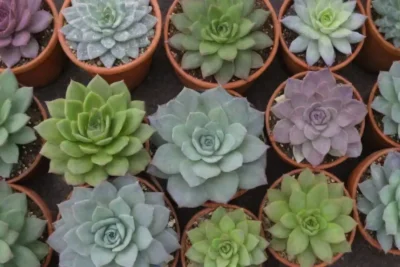
How to Differentiate Between Various Types of Cactus Succulents

Introduction
Cacti and succulents hold a special place in the hearts of plant enthusiasts and causal growers alike. These plants, known for their resilience and unique aesthetics, have evolved in some of the most arid environments on Earth. Their distinctive features, ranging from spiny exteriors to striking shapes, make them an appealing choice for decorative purposes and landscape design. However, with the plethora of cactus and succulent varieties available, understanding how to differentiate between them can prove to be a challenge.
This article aims to provide an extensive guide on how to distinguish between various types of cactus succulents. We will delve into their characteristics, growth habits, and care requirements, assisting both new and seasoned plant lovers to cultivate a thriving collection of these fascinating hardy plants. With a comprehensive overview, you will gain the confidence to identify different varieties, ensuring that your gardening experience is as fulfilling as it is rewarding.
Understanding the Basics of Cactus and Succulents
To differentiate between various types of cactus succulents, it is essential to first understand the basics around the two main categories—cacti and succulents. While all cacti are classified as succulents, not all succulents are cacti. Succulents represent a broad classification of plants that have adapted to conserve water, allowing them to thrive in arid conditions. Their thick, fleshy tissues store moisture, making them resilient in dry climates.
Cacti, on the other hand, belong to the family Cactaceae and are characterized by their distinct stems that have adapted to retain water. What sets cacti apart from other succulents is the presence of areoles, small, cushion-like structures from which spines, flowers, and new branches emerge. Areoles are a unique feature that can help you identify cacti among other succulent varieties. Understanding these foundational differences lays the groundwork for further exploration into the specific types of succulents and cacti you may encounter in your gardening journey.
Geographical Distribution and Habitat
Cacti primarily thrive in North America, along with some species in South America, where they have evolved to adapt to extreme drought and high temperatures. These environments range from the Sonoran Desert to mountainous regions, displaying a remarkable diversity in habitat. On the other hand, succulents are found in various regions worldwide, including Africa, Asia, and Madagascar. This broader distribution implies that succulents exhibit a greater variety of forms and survival strategies, with some even growing in temperate or tropical environments.
The diverse geographical distribution of these plants affects their morphology and care requirements. For instance, succulents adapted to milder climates may require more water than their desert-dwelling cactus counterparts. Understanding these habitats provides insight into the environmental preferences of different cacti and succulents, aiding you in creating optimal growing conditions for your plants.
Common Characteristics of Cacti and Succulents
Apart from their habitat differences, cacti and succulents exhibit several discernible characteristics that aid in identification. Cacti generally feature fleshy stems, which can be cylindrical or flattened, allowing them to store moisture effectively. Their spiny exterior serves as a deterrent to herbivores, while also providing some filtered shade to the stem. In contrast, many succulents have smooth or slightly textured leaves that can vary in color from deep green to vibrant hues, with some species showcasing even a blush of pink or purple.
 Sedum Varieties: Unique Traits and Growing Techniques Unveiled
Sedum Varieties: Unique Traits and Growing Techniques UnveiledAnother notable characteristic is their flowering patterns. Cacti produce distinctive flowers that bloom in an array of design and color, usually in response to specific climatic changes. Succulents, meanwhile, often feature clusters of small flowers that form atop their rosettes or along their stems. Variances in flowering can also provide clues to differentiating between cactus and succulent species. Overall, recognizing these common characteristics creates a solid foundation for further identification efforts.
Key Types of Cactus Succulents
Understanding the distinctions among the various types of cactus succulents is crucial for any plant lover. While the range is vast, let's explore some major cactus families and their defining characteristics:
1. Opuntia (Prickly Pear Cacti)
The Opuntia genus, commonly known as prickly pears, features flat pads known as cladodes, which serve as modified stems for water storage. This type of cactus often bears distinctive clusters of spines and glochids, small hair-like structures that can become stuck in the skin. Prickly pears are frequently found in desert environments, where they bloom beautiful flowers in shades of yellow, pink, or red.
These cacti are known for their edible fruit, known as tunas, which can be harvested and consumed. Understanding this distinguishes Opuntia from other cacti, as their ability to produce edible fruit is a notable feature. While prickly pear cacti thrive in full sun, they benefit from well-drained soil rich in organic matter. These unique features highlight the importance of recognizing specific characteristics to differentiate Opuntia from other cactus varieties.
2. Echinocactus (Barrel Cactus)
The Echinocactus family, often referred to as barrel cacti, exhibits a robust, rounded shape resembling a barrel. Many varieties are adorned with pronounced ribs and elongated spines, resembling beautiful spikes that add flair to any collection. Echinocacti are typically grown in desert regions and can store significant amounts of water, allowing them to withstand extended dry periods.
One of their most distinct features is their flowering habit. During flowering season, barrel cacti produce vibrant blooms that emerge from the top of their structure. These colorful flowers are vital to local ecosystems, attracting pollinators and signaling the health of the plant. Recognizing the characteristics of Echinocactus ensures you can effectively care for and appreciate these striking specimens.
3. Mammillaria (Pincushion Cactus)
Another fascinating group of cacti is the Mammillaria genus, commonly known as pincushion cacti. These cacti are small in stature and typically have a cylindrical shape, covered in clusters of areoles from which spines protrude. The distinguishing characteristic of Mammillaria is their tuberculated structure, which appears as rounded bumps or knobs on the stem, hence their name.
 Understanding the Pictorial Wonders of Fenestraria Succulents
Understanding the Pictorial Wonders of Fenestraria SucculentsPincushion cacti are generally abundant, blooming small, bell-shaped flowers in vibrant shades of pink, yellow, or white, creating an eye-catching display. These cacti can thrive in various conditions, including both indoor and outdoor environments. Knowing the traits of Mammillaria enhances your ability to identify these charming miniatures easily while providing the care they require to flourish.
Care and Cultivation of Cactus Succulents

Successfully nurturing cactus succulents requires an understanding of their unique care needs. Different types have varied requirements concerning sunlight, soil, watering, and temperature, all of which can impact their overall health and growth.
Sunlight Requirements
One essential aspect of cactus care is ensuring they receive adequate sunlight. Most cacti require full sun to thrive, ideally receiving at least 6 hours of direct sunlight each day. For instance, prickly pear cacti flourish in arid, sun-drenched environments, while barrel cacti also thrive under these conditions. Succulents, while benefiting from abundant light, can sometimes prefer partial shade, especially in hotter months. Understanding the specific light needs of different cacti ensures you position them in optimal locations to promote healthy growth.
Soil and Drainage
Another crucial factor in caring for cacti and succulents is the soil they are grown in. These plants require well-draining soil to prevent root rot, a common issue with overly saturated conditions. A mix of potting soil, sand, and perlite typically creates the ideal growing medium. These components allow for increased drainage while retaining some essential moisture. Different types of cacti, such as Echinocactus or Mammillaria, may have slight variations in soil preferences, adding further importance to understanding their unique growing needs.
Watering Practices
Watering is perhaps one of the most critical aspects of cactus care. These plants operate under different guidelines compared to typical houseplants. Cactus and succulent varieties survive well during drought and need only to be watered when the soil has thoroughly dried out. During the growing season (spring and summer), cacti should be watered deeply but infrequently, while in winter, they require minimal moisture. Observing your cacti and understanding their needs will help ensure they thrive.
Conclusion
Differentiating between various types of cactus succulents is a gratifying endeavor for plant lovers. Not only does it increase your understanding and appreciation of these remarkable plants, but it also fosters their successful cultivation. From recognizing the unique features of prickly pears, barrel cacti, and pincushion cacti, to comprehending their care requirements, each aspect contributes to a seamless gardening experience.
 The Ultimate Guide to Rosette Succulents and Their Types
The Ultimate Guide to Rosette Succulents and Their TypesAs you continue to learn and grow alongside cacti and succulents, remember that observation is key. By paying attention to their changing needs, adapting your care practices, and respecting their diverse characteristics, you will cultivate a flourishing environment for these beautiful, water-conserving wonders. With this guide, you’re better equipped to enjoy the fascinating world of cacti and succulents, creating a vibrant and diverse collection that will bring joy for years to come.
If you want to read more articles similar to How to Differentiate Between Various Types of Cactus Succulents, you can visit the Types of Succulents category.




You Must Read